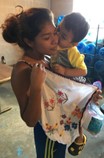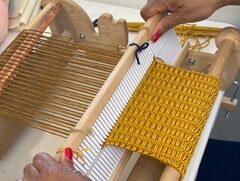Summer 2024 Anglican Commentary
 My fingers ache from passing a wooden shuttle over and under strands of warp yarn. It’s a soft, burgundy-colored yarn. Bit by bit, a wool scarf is taking shape. I may be a beginner with this nifty tabletop loom, but I have the expert help of Carmen and Yasmine (names and destinations changed to protect identities).
My fingers ache from passing a wooden shuttle over and under strands of warp yarn. It’s a soft, burgundy-colored yarn. Bit by bit, a wool scarf is taking shape. I may be a beginner with this nifty tabletop loom, but I have the expert help of Carmen and Yasmine (names and destinations changed to protect identities).
We’re in the workshop of Artisans Beyond Borders at La Casa De La Misericordia y de Todas Las Naciones, “La Casa” for short, a hostel in Nogales, Sonora, Mexico for migrants making their way to a better life in the U.S. Carmen, now the lead teacher here, fled Guerrero, a violence-ridden Mexican state. Yasmine, both weaver and bordadora (embroiderer), came here from West Africa’s Senegal, a nation with 51 percent poverty racked by political unrest.
You might say the two asylum-seekers are weaving their own lives. “Whatever happens,” Justice Sandra Day O’Connor once pointed out, “is the result of the whole tapestry of one’s life and all the weavings of individual threads form one to another that create something.”
Practicing one’s craft is the epitome of dignity. That’s exactly what La Casa enables Carmen and Yasmine to do. La Casa, not just a house but a small campus of buildings, is the jewel in the crown of the Episcopal Diocese of Arizona’s Borderland Ministry led by Father JJ Bernal, who, like me, is visiting La Casa today.
Flashback to this morning: I drove 90 minutes across the desert from Tucson with Valarie “Val” James, the Arizona artist and art therapist who made Artisans Beyond Borders (ABB for short) possible. A volunteer organization based at Grace St. Paul’s Episcopal Church in Tucson, the group fosters grace and agency for asylum seekers through practice of cultural arts. The skills its bordadoras and tejedoras (weavers) like Carmen and Yasmine carry from far places are already enriching our country. A recent exhibit of their work at Boston College’s Thomas P. O’Neill Library, is just one of many, past and upcoming, in the U.S.
Val, Father JJ and I met up in a Burger King lot on the Arizona side of the border. We lugged a shopping cart and bags heavy with yarn plus a floor lamp for Carmen’s and Yasmine’s workshop past the uniformed Mexican border guard. He took a quick peek into our bags and waved us on into Nogales.
Nogales, Sonora is a bustling Mexican city of 265,000 on the border with its little sister, Nogales, Arizona, a town of just 20,000. We crammed into a cab for the short ride to La Casa, located on a dusty hilltop on the outskirts.
As we pulled up, a group of young men were learning mechanical skills by dismantling a car engine, helpful, it is hoped, to finding work in the U.S. Our country needs over 100,000 new workers per year to alleviate a shortage of auto technicians according to MarketWatch.com.
But La Casa, inspiringly led by Sister Angelica Bacias Mejia, a Catholic nun, looks beyond the material to the psychological and spiritual needs of migrants, the kind of needs outlined by Notre Dame theologian Dan Groody (A Theology of Migration, 2022): “freedom and self-expression, safety and protection, agency and justice, and community and belonging.”
Weaving in the quiet workshop and chatting, I learn that, after meeting with U.S. border officials, Carmen will head to California to practice her craft. Yasmine, destined to meet up with Senegalese relatives in Maryland, will then take over as lead artisan.
In the La Casa workshop, bordadoras craft the traditional manta cloth of Mexico. It’s used to wrap a family’s food, to serve as a wall hanging or a devotional cloth for an altar. I chat via “Google Translate” French with Yasmine, who both weaves and embroiders. She shows me her breathtaking manta of The Virgin of Guadalupe, who appeared to the Mexican Aztec peasant, Juan Diego, in 1531. Guadalupe’s picture is everywhere at La Casa. Protectress of all migrants, Guadalupe, like migrant artisans themselves, transcends borders.
Father JJ and Val pop in to check on our progress. Val assures me my scarf’s rough edges are typical for beginning weavers, and that I’ll learn to get straight edges in time. Meanwhile, the clamor of children surrounds us. Throughout Mexico today it’s El Día del Niño y de la Niña, a day to celebrate children. Games and parties are happening across the shelter’s campus.
As we keep weaving, we hear cries of “piñata! piñata!” Like everyone at La Casa, I rush to the playground where 55 children gather for turns swinging a stick at the colorful candy-filled piñata.
It’s Día del Niño y de la Niña. In the midst of many long journeys, it’s time to celebrate.
Martin Dickinson, Washington National Cathedral Sanctuary Ministry

